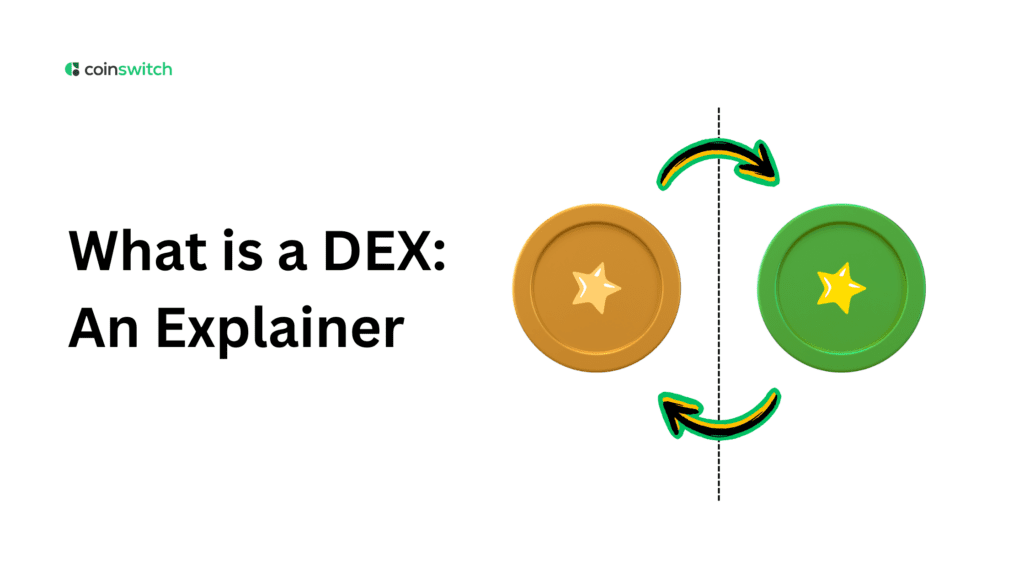\Crypto markets never sleep, and neither do the platforms that power them. If you’ve ever bought Bitcoin on a big platform like CoinSwitch, you’ve used a centralized exchange, where the company runs the platform, holds custody of your funds, and takes care of matching your trades. But behind the hype, another model has been growing quietly, and in the last few years, it has exploded: the DEX, short for decentralized crypto exchange.
Unlike CEXs, a decentralized crypto exchange, or a DEX, is a platform that does not rely on a central authority. Instead, it has an automated system that enables exchanges between buyers and sellers. The transaction it enables is a peer-to-peer one. They also use smart contracts (self-executing bits of code on a blockchain) to facilitate private transactions.
How do DEXs work?
How does a decentralized crypto exchange actually function? To understand that, you need to picture two different models.
The first is the order-book model, which feels familiar if you’ve traded stocks. Order book DEX development refers to the creation of decentralized exchanges that use order book mechanisms for matching buy and sell orders. Traders post bids (buy orders) and asks (sell orders). The exchange’s matching engine connects the dots. Some DEXs, like dYdX, try to replicate this structure but keep it decentralized.
The second is the Automated Market Maker (AMM) model, which most modern DEXs use. Here’s how it works: instead of waiting for another trader to be on the opposite side of your trade, you swap against a pool of funds locked in by other users. These people are called liquidity providers (LPs). They deposit token pairs into smart contract pools, and the pool’s algorithm sets the price using formulas like xy = k*.
Let’s understand this better. On Uniswap, if you want to trade ETH for USDC, you’re not waiting for Bob on the other side to sell his USDC. Instead, you tap into the ETH/USDC liquidity pool. The more ETH you add, the pool’s ratio shifts, and the price adjusts. It’s math, not a market maker behind a desk, that decides what rate you get.
DEXs rely heavily on user-controlled crypto wallets as DEXs are non-custodial. Here, users connect their personal wallets to the platform to hold and trade their funds directly, rather than transferring them to a central exchange wallet like on a centralized exchange. You don’t create an account with an email and a password. Instead, you connect something like MetaMask, Phantom, or Trust Wallet. When you approve a transaction, the smart contract interacts directly with your wallet, executes the swap, and updates balances on-chain. Your funds never sit in the exchange’s custody, an important shift that changes the power dynamic entirely.
Read More: The three different types of cryptocurrency exchanges: CEXs, DEXs, and hybrid exchanges
What are the potential benefits of using a DEX?
Why would someone choose a DEX over a polished, user-friendly centralized exchange? There are several reasons, as we will discuss.
Control over funds. This is the biggest one. In a DEX, you don’t park your money with a third party. If an exchange gets hacked, collapses, or runs away with customer funds, think Mt. Gox or FTX, you’re left empty-handed. On a DEX, the tokens stay in your wallet until the moment of trade. That’s peace of mind.
No reliance on central authority. DEXs differ from CEXs in that they do not rely on a central authority to facilitate trade. Instead, DEXs use smart contracts and blockchain technology to enable peer-to-peer trading of crypto assets.
Early access to tokens. New projects often launch on DEXs first because there are no listing gatekeepers. For adventurous traders, this means you can grab tokens before they ever hit centralized platforms.
Privacy. While regulations are tightening, many decentralized crypto exchanges still let you trade without handing over personal data. For users who value anonymity, that’s a big plus.
Innovation playground. DEXs gave birth to DeFi trends like yield farming, liquidity mining, and flash loans. They’re not just exchanges; they’re labs where new financial products are tested daily.
Read More: The Most Expensive NFTs Ever Sold [As of Oct 2025]
What are some potential downsides?
For all the benefits, a DEX isn’t always sunshine and smooth trades. Here’s where things get tricky:
Liquidity issues. On big tokens like ETH or SOL, liquidity is deep. But trade a smaller coin on a less popular pool, and you might find massive slippage. Your $1,000 trade could move the price more than you expect, leaving you worse off.
User experience. Let’s be honest: centralized apps feel like polished fintech products. DEXs, especially in their early versions, felt clunky. Wallet connections fail, gas fees pop up, and you have to know what slippage tolerance means. For beginners, that’s intimidating.
Absence of a trusted intermediary. Conflict resolution becomes difficult in the absence of a trusted intermediary.
Smart contract risk. DEXs run on code. And code can have bugs. We’ve seen multimillion-dollar hacks where vulnerabilities in smart contracts got exploited. Bigger platforms like Uniswap are audited and safer, but smaller DEXs carry a higher risk.
So, while decentralization hands you control, it also makes you responsible.
How do you interact with a DEX?
Using a decentralized crypto exchange doesn’t feel like logging onto a brokerage app. The process is different, and that’s both empowering and confusing for first-timers.
Step 1: Get a wallet. Download a non-custodial wallet like MetaMask, Phantom, or Trust Wallet. This wallet is your passport to Web3.
Step 2: Fund it. Buy crypto on a centralized exchange or via on-ramps and send it to your wallet. Always keep a bit of the native token (ETH, SOL, etc.) to pay gas fees.
Step 3: Connect to the DEX. Go to the exchange site, Uniswap, SushiSwap, PancakeSwap, take your pick, and click “Connect Wallet.” Approve the connection in your wallet app.
Step 4: Place your trade. Select the tokens you want to swap. The DEX shows you the rate, liquidity, and estimated gas fees.
Step 5: Confirm. Hit “Swap,” approve in your wallet, and wait for the blockchain to process the transaction. Depending on the network, it could be seconds or minutes.
Step 6: Done. Tokens arrive straight into your wallet. No account balances to check, no middleman holding your funds.
For newcomers, the flow takes practice. But once you get the hang of it, it feels liberating, like walking into a market where you and your wallet are all you need.
How do DEX fees work?
Here’s where people sometimes get surprised. DEX fees aren’t hidden, but they work differently from centralized platforms.
Network fees (Gas fees). Every transaction on-chain requires a fee. On blockchains like Ethereum, this is the infamous gas fee. On Solana or Polygon, it’s pennies, but it’s still there. This fee goes to miners or validators who process your transaction.
DEX protocol fees. Most AMM-based DEXs charge a small percentage per trade (commonly 0.05%–0.3%). This doesn’t go to the firm; it goes to liquidity providers who supply tokens in the pool. That’s the incentive for them to lock up their funds.
Swap fees: This is the fee charged for exchanging one token for another on the DEX.
The good news? With scaling solutions, DEX fees are coming down. Platforms on Arbitrum, Optimism, or Solana make trading far cheaper than Ethereum’s main chain.
Conclusion
A DEX mirrors the philosophy of crypto itself: decentralization, self-custody, and open access.
It gives users control of their funds, removes reliance on intermediaries, and opens the door to thousands of tokens and financial experiments. At the same time, it demands knowledge, caution, and a willingness to accept personal responsibility.
For some, that trade-off feels risky. For others, it’s exactly why they got into crypto in the first place. Either way, ignoring DEXs isn’t an option anymore. They’re too big, too innovative, and too central to the functioning of digital markets.
FAQs
1. What is an example of a DEX?
A classic example is Uniswap, the decentralized crypto exchange (DEX) built on the Ethereum blockchain. It lets users swap tokens directly from their wallets without signing up for an account. Other popular names include PancakeSwap on Binance Smart Chain and dYdX, which uses an order-book style for trading. Each one works differently, but the idea stays the same: trades happen peer-to-peer, powered by smart contracts.
2. What does the DEX stand for?
DEX stands for Decentralized Exchange. In crypto, people often refer to a decentralized crypto exchange to highlight that it’s not controlled by one firm or authority. Instead, everything runs through blockchain technology, where code and smart contracts replace traditional intermediaries.
3. What is DEX, and how does it work?
A DEX is a platform where you trade crypto directly with other users. You connect a wallet like MetaMask or Phantom, pick the tokens you want to swap, and approve the transaction. Instead of going through a central authority, the trade is executed by smart contracts. In AMM-based DEXs like Uniswap, users trade directly with liquidity pools instead of with other traders via an order book. In order-book DEXs like dYdX, bids and asks match in real-time. Either way, your funds never leave your wallet until the trade happens.
4. Is DEX safe?
A DEX is as safe as the code it runs on and the habits of its users. On the positive side, you keep custody of your funds; no one can freeze or misuse your tokens. But there are risks too. Smart contracts can have bugs, smaller DEXs may face hacks, and user mistakes (like sending tokens to the wrong address) can’t be undone. Well-audited platforms like Uniswap or PancakeSwap are considered safer, but in the end, using a decentralized crypto exchange means taking responsibility for your security.








